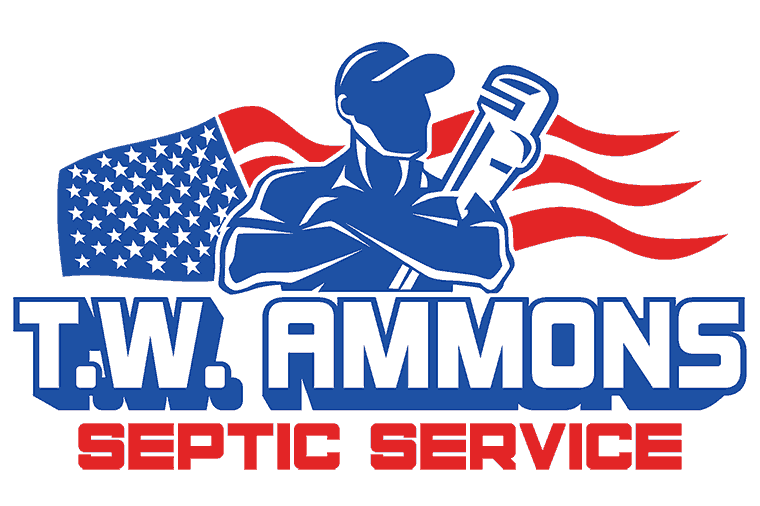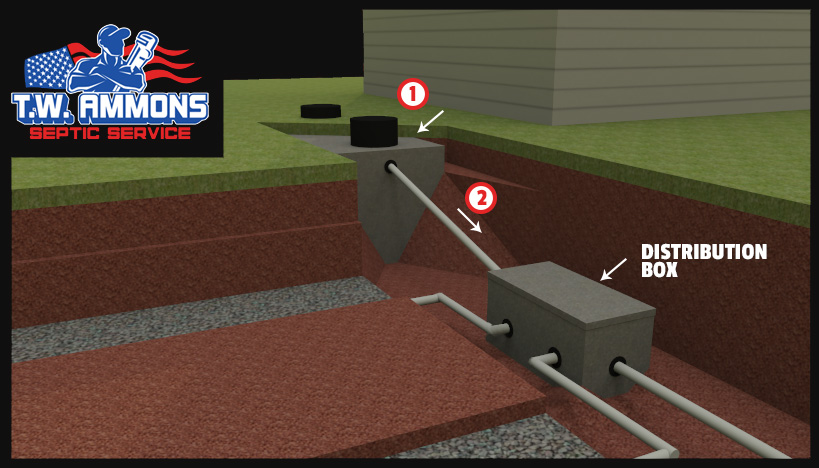Hello and welcome to the second article in our Septic Facts – FAQ. With our first article we talked at length about the Septic Tank. Today we discuss the Drain Field: the septic system’s largest and most vital component.
What is the Septic Drain Field?
The septic drain field is the largest part of a septic system. The individual parts of a septic system typically consist of the septic tank, a distribution box, and drain field lines (also known as “leach lines”). The system works together in the following steps: [Note that in the shared illustrations a conventional system is shown.]
1. Everything flushed and drained enters the septic tank and is filtered by a baffle. Any scum or sludge is kept on the “inlet” end of the tank. Mostly liquid waste passes over to the outlet end of the tank.
2. The separation of solids is further aided by a tee and a filter in the “outlet”. The filter only allows liquid to pass into the distribution box.
3. From the distribution box the waste water flows out into several pipes that are connected to the drain field. In each line of a conventional septic system is 12” inches of gravel aggregate.
4. The gravel aggregate acts as a filter to separate impurities carried along with the liquid. At the base of the aggregate is formed a layer of biomat that holds bacterial slime. This slime eats away at the impurities as it builds up in the gravel aggregate. The leftover liquid makes its way into the surrounding soil.
5. The liquid is filtered further through mother earth’s surrounding soil. The completed filtration eliminates potential diseases from reaching our environment and ourselves. The cycle of life continues!
The Distribution Device
The term ‘device’ is used to describe any state approved method of evenly distributing the waste water throughout the drain field. Some septic systems have individual drop boxes, others have a single distribution box. Some septic systems have a pressure manifold, while the most costly have individual valves and end caps that are housed in ground level boxes.
What’s An Aggregate? (The Final Filt-eer)
We’ve already shown illustrations of gravel aggregate. But it’s important to note that there are many others used in septic systems today. Conventional systems are filled with 12″ inches of gravel rock, having a 4” corrugated pipe running their length. Other aggregate material can include tire chips, plastic chambers, “styrofoam” style gravel, and panels made from cinder blocks. Around our area we use T&J Panels.
Gravity Fed vs Pump Septic Systems
Most drain fields are fed by gravity, holding a lower depth than the septic tank and distribution device. While others are pumped to uphill or off-site. Additionally, in North Carolina all pump septic systems have an additional septic tank that holds the septic pump.
The style of drain field installed is determined by the state’s environmental health department. They survey the lot and have soil test completed to draw up a septic permit. This is why if suitable soil is found uphill or off-site, a pump tank is also installed.
How Large Is a Typical Drain Field?
For new installation, the size of the drain field will always match it’s application. There will also be a 100% percent repair area.
A conventional septic system’s lines are 3′ feet wide. Between each line is 6′ feet of untouched “virgin” soil. There are also drain field “beds.” Basically lines that have been pushed together with no “virgin” soil between them. As an aside, in some advanced septic systems the lines may be 2′ feet wide.
The line’s depth is determined by the state after soil test. For existing septic systems, minimum drain field trench depth is 6″ inches while maximum depth could be 5′ feet! On new installations the trench depth is normally 36″ inches at most, with 6″ inches being the minimum.
Taking Care of Your Septic Drain Field in 3 Easy Steps:
1. Never drive an automobile or heavy equipment over the septic tank, distribution device, or drain field. The excess weight will cause compaction of the soil and drain field aggregate, it can lead to damage to the septic tank and distribution device. Lawn mowers and foot traffic are perfectly safe to be above a well maintained septic system.
2. Don’t build anything over your septic tank, distribution device, or drain field. By building over your drain field its proficiency is greatly limited. This is because 25% of the waste water absorption is done by the grass grown over the drain field.
3. Note your water usage. A septic system does not have an unlimited capacity. The more water your household uses, the greater the likelihood of problems with the septic system.
Water conservation practices can help reduce the amount of waste water generated in the home. Periodically check your plumbing for leaky faucets and toilets. Uncorrected leaks can more than double the amount of water you use. Many soils can absorb the 200 to 250 gallons of waste water produced daily by a family of four. However, 250 gallons extra could waterlog the soil!
If you notice smelly water pooling in your yard then you may have a failing septic system. Waste water should always filter through the ground without breaking the surface. We encourage you to contact us if you happen to be in our part of North Carolina. Or look up a nearby septic repair specialist near you to get your septic working right. Also check out our page on Terralift, an effective and inexpensive way to fix your drain field without tearing up your yard.





